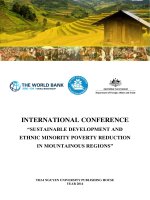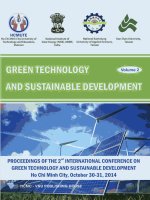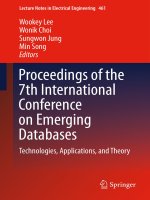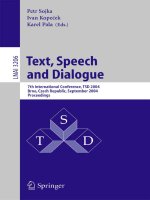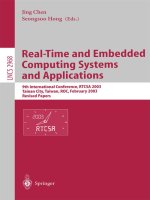Springer text speech and dialogue 7th international conference TSD 2004 proceedings (2005) ling
Bạn đang xem bản rút gọn của tài liệu. Xem và tải ngay bản đầy đủ của tài liệu tại đây (25.93 MB, 687 trang )
Lecture Notes in Artificial Intelligence
3206
Edited by J. G. Carbonell and J. Siekmann
Subseries of Lecture Notes in Computer Science
TEAM LinG
This page intentionally left blank
Petr Sojka
Karel Pala (Eds.)
Text, Speech
and Dialogue
7th International Conference, TSD 2004
Brno, Czech Republic, September 8-11, 2004
Proceedings
Springer
eBook ISBN:
Print ISBN:
3-540-30120-8
3-540-23049-1
©2005 Springer Science + Business Media, Inc.
Print ©2004 Springer-Verlag
Berlin Heidelberg
All rights reserved
No part of this eBook may be reproduced or transmitted in any form or by any means, electronic,
mechanical, recording, or otherwise, without written consent from the Publisher
Created in the United States of America
Visit Springer's eBookstore at:
and the Springer Global Website Online at:
Preface
This volume contains the Proceedings of the 7th International Conference on Text, Speech
and Dialogue, held in Brno, Czech Republic, in September 2004, under the auspices of the
Masaryk University.
This series of international conferences on text, speech and dialogue has come to constitute a major forum for presentation and discussion, not only of the latest developments in
academic research in these fields, but also of practical and industrial applications. Uniquely,
these conferences bring together researchers from a very wide area, both intellectually and
geographically, including scientists working in speech technology, dialogue systems, text
processing, lexicography, and other related fields. In recent years the conference has developed into a primary meeting place for speech and language technologists from many different
parts of the world and in particular it has enabled important and fruitful exchanges of ideas
between Western and Eastern Europe.
TSD 2004 offered a rich program of invited talks, tutorials, technical papers and poster
sessions, as well as workshops and system demonstrations. A total of 78 papers were accepted
out of 127 submitted, contributed altogether by 190 authors from 26 countries. Our thanks
as usual go to the Program Committee members and to the external reviewers for their
conscientious and diligent assessment of submissions, and to the authors themselves for
their high-quality contributions. We would also like to take this opportunity to express our
appreciation to all the members of the Organizing Committee for their tireless efforts in
organizing the conference and ensuring its smooth running. In particular, we would like to
mention the work of the Chair of the Program Committee, Hynek Hermansky. In addition we
would like to thank some other people, whose efforts were less visible during the conference
proper, but whose contributions were of crucial importance. Dagmar Janoušková and Dana
Komárková took care of the administrative burden with great efficiency and contributed
substantially to the detailed preparation of the conference. The
of Petr Sojka
resulted in the extremely speedy and efficient production of the volume which you are
now holding in your hands, including preparation of the subject index, for which he took
responsibility. Last but not least, the cooperation of Springer-Verlag as the publisher of these
proceedings is gratefully acknowledged.
July 2004
Karel Pala
Organization
TSD 2004 was organized by the Faculty of Informatics, Masaryk University, in cooperation
with the Faculty of Applied Sciences, University of West Bohemia in
The conference
webpage is located at />
Program Committee
Jelinek, Frederick (USA), General Chair
Hermansky, Hynek (USA), Executive Chair
Agirre, Eneko (Spain)
Baudoin, Geneviève (France)
(Czech Republic)
Ferencz, Attila (Romania)
Gelbukh, Alexander (Mexico)
(Czech Republic)
(Czech Republic)
Hovy, Eduard (USA)
(Czech Republic)
Krauwer, Steven (The Netherlands)
Matoušek, Václav (Czech Republic)
Nöth, Elmar (Germany)
Oliva, Karel (Austria)
Pala, Karel (Czech Republic)
(Slovenia)
(Czech Republic)
Psutka, Josef (Czech Republic)
Pustejovsky, James (USA)
Rothkrantz, Leon (The Netherlands)
Schukat-Talamazzini, E. Günter (Germany)
Skrelin, Pavel (Russia)
Smrž Pavel (Czech Republic)
Vintsiuk, Taras (Ukraine)
Wilks, Yorick (UK)
Referees
Olatz Arregi, Iñaki Alegria, Lukáš Burget, Hiram Calvo-Castro, Arantza Casillas, Pavel
Cenek, Martin Cooke, Koldo Gojenola Galletebeitia, Martin Holub, Aleš Horák,
Petr Jenderka, Martin Karafiát,
Eva Mráková, Fabio Pianesi, Vlasta
Radová, Hae-Chang Rim, Pavel Rychlý,
Petr Schwarz, Igor Szöke, Victor
Zakharov
Organizing Committee
Aleš Horák, Dagmar Janoušková, Dana Komárková (Secretary),
(Co-chair),
Karel Pala (Co-chair), Adam Rambousek, Anna Sinopalniková, Pavel Smrž, Petr Sojka
(Proceedings)
Supported by:
International Speech Communication Association
Table of Contents
I
Invited Papers
Speech and Language Processing: Can We Use the Past to Predict the Future?
Kenneth Church (Microsoft, USA)
3
Common Sense About Word Meaning: Sense in Context
Patrick Hanks (Berlin-Brandenburg Academy of Sciences, Germany),
James Pustejovsky (Brandeis University, USA)
15
ScanSoft’s Technologies
Jan Odijk (ScanSoft Belgium)
19
II
Text
A Positional Linguistics-Based System for Word Alignment
Ana-Maria Barbu (Romanian Academy, Bucharest, Romania)
23
Handling Multi-word Expressions Without Explicit Linguistic Rules in an MT System
Akshar Bharati, Rajeev Sangal, Dipti Mishra, Sriram Venkatapathy, Papi Reddy T.
(International Institute of Information Technology, Hyderabad, India)
31
The Szeged Corpus: A POS Tagged and Syntactically Annotated Hungarian Natural
Language Corpus
Dóra Csendes, János Csirik, Tibor Gyimóthy (University of Szeged, Hungary)
41
Item Summarization in Personalisation of News Delivery Systems
Alberto Díaz, Pablo Gervás (Universidad Complutense de Madrid, Spain)
49
IR-n System, a Passage Retrieval Architecture
Fernando Llopis, Héctor García Puigcerver, Mariano Cano, Antonio Toral,
Héctor Espí (University of Alicante, Spain)
57
Event Clustering in the News Domain
Cormac Flynn, John Dunnion (University College Dublin, Ireland)
65
HANDY: Sign Language Synthesis from Sublexical Elements Based on an XML
Data Representation
László Havasi (PannonVision, Szeged, Hungary), Helga M. Szabó
(National Association of the Deaf, Budapest, Hungary)
Using Linguistic Resources to Construct Conceptual Graph Representation of Texts
Svetlana Hensman, John Dunnion (University College Dublin, Ireland)
73
81
VIII
Table of Contents
Slovak National Corpus
Alexander Horák, Lucia Gianitsová, Mária Šimková, Martin Šmotlák,
Radovan Garabík (Slovak Academy of Sciences Bratislava, Slovakia)
Grammatical Heads Optimized for Parsing and Their Comparison with Linguistic
Intuition
Vladimír Kadlec, Pavel Smrž (Masaryk University in Brno, Czech Republic)
89
95
How Dominant Is the Commonest Sense of a Word?
Adam Kilgarriff (Lexicography MasterClass Ltd. and ITRI,
University of Brighton, UK)
103
POS Tagging of Hungarian with Combined Statistical and Rule-Based Methods
András Kuba, András Hócza, János Csirik (University of Szeged, Hungary)
113
Grammatical Relations Identification of Korean Parsed Texts Using Support Vector
Machines
Songwook Lee, Jungyun Seo (Sogang University, Seoul, Korea)
121
Clustering Abstracts Instead of Full Texts
Pavel Makagonov (Mixteca University of Technology, Mexico), Mikhail Alexandrov
(National Polytechnic Institute, Mexico), Alexander Gelbukh (National Polytechnic
Institute, Mexico)
129
Bayesian Reinforcement for a Probabilistic Neural Net Part-of-Speech Tagger
Manolis Maragoudakis, Todor Ganchev, Nikos Fakotakis
(University of Patras, Greece)
137
Automatic Language Identification Using Phoneme and Automatically Derived
Unit Strings
(FEEC VUT Brno, Czech Republic), Igor Szöke (FIT VUT Brno,
Czech Republic and ESIEE Paris, France), Petr Schwarz (FIT VUT Brno,
Czech Republic), and
(FIT VUT Brno, Czech Republic)
147
Slovak Text-to-Speech Synthesis in ARTIC System
Daniel Tihelka (University of West Bohemia in Pilsen,
Czech Republic)
155
Identifying Semantic Roles Using Maximum Entropy Models
Paloma Moreda, Manuel Fernández, Manuel Palomar, Armando Suárez
(University of Alicante, Spain)
163
A Lexical Grammatical Implementation of Affect
Matthijs Mulder (University of Twente, Enschede, The Netherlands and Parabots
Services, Amsterdam, The Netherlands) Anton Nijholt (University of Twente,
Enschede, The Netherlands), Marten den Uyl, Peter Terpstra (Parabots Services,
Amsterdam, The Netherlands)
171
Table of Contents
IX
Towards Full Lexical Recognition
Duško Vitas, Cvetana Krstev (University of Belgrade)
179
Discriminative Models of SCFG and STSG
Antoine Rozenknop, Jean-Cédric Chappelier, Martin Rajman (LIA, IIF, IC, EPFL,
Lausanne, Switzerland)
187
Coupling Grammar and Knowledge Base: Range Concatenation Grammars and
Description Logics
Benoît Sagot (Université Paris 7 and INRIA, France), Adil El Ghali
(Université Paris 7, France)
195
Balancing Manual and Automatic Indexing for Retrieval of Paper Abstracts
Kwangcheol Shin (Chung-Ang University, Korea), Sang-Yong Han (Chung-Ang
University, Korea), Alexander Gelbukh (National Polytechnic Institute, Mexico)
203
Unsupervised Learning of Rules for Morphological Disambiguation
Pavel Šmerk (Masaryk University in Brno, Czech Republic)
211
Ambiguous Supertagging Using a Feature Structure
François Toussenel (University Paris 7, France)
217
A Practical Word Sense Disambiguation System with High Performance for Korean
Yeohoon Yoon (ETRI, Republic of Korea), Songwook Lee (Sogang University, Seoul,
Republic of Korea), Joochan Sohn (ETRI, Republic of Korea)
225
Morphological Tagging of Russian Texts of the
Century
Victor Zakharov, Sergei Volkov (St. Petersburg State University, Russia)
235
III
Speech
Large Vocabulary Continuous Speech
Recognition for Estonian Using Morphemes and Classes
Tanel Alumäe (Tallinn Technical University, Estonia)
A New Classifier for Speaker Verification Based on the Fractional Brownian
Motion Process
Ricardo Sant Ana, Rosângela Coelho (Instituto Militar de Engenharia, Rio de
Janeiro, Brazil), Abraham Alcaim (Pontifícia Universidade Católica do Rio de
Janeiro, Brazil)
A Universal Human Machine Speech Interaction Language for Robust Speech
Recognition Applications
Levent M. Arslan
University Istanbul, Turkey)
Embedded ViaVoice
Tomáš Beran, Vladimír Bergl, Radek Hampl, Pavel Krbec, Jan Šedivý,
(IBM Research Prague, Czech Republic)
245
253
261
269
X
Table of Contents
New Speech Enhancement Approach for Formant Evolution Detection
Jesus Bobadilla (U.P.M. Madrid, Spain)
275
Measurement of Complementarity of Recognition Systems
Lukáš Burget (VUT Brno, Czech Republic)
283
Text-to-Speech for Slovak Language
Martin Klimo, Igor Mihálik, Radovan Mladšík (University of Žilina,
Slovakia)
291
Speaker Verification Based on Wavelet Packets
Todor Ganchev, Mihalis Siafarikas, Nikos Fakotakis (University of Patras, Greece)
299
A Decoding Algorithm for Speech Input Statistical Translation
Ismael García-Varea (Univ. de Castilla-La Mancha, Albacete, Spain), Alberto
Sanchis, Francisco Casacuberta (Univ. Politécnica de Valencia, Spain)
307
Aggregation Operators and Hypothesis Space Reductions in Speech Recognition
Gábor Gosztolya, András Kocsor (University of Szeged, Hungary)
315
Combinations of TRAP Based Systems
František Grézl (Brno University of Technology, Czech Republic and IDIAP,
Switzerland)
323
Automatic Recognition and Evaluation of Tracheoesophageal Speech
Tino Haderlein, Stefan Steidl, Elmar Nöth, Frank Rosanowski, Maria Schuster
(University Erlangen-Nüremberg, Germany)
331
Using Neural Networks to Model Prosody in Czech TTS System Epos
Petr Horák (Academy of Sciences, Prague, Czech Republic), Jakub Adámek
(Charles University, Prague, Czech Republic), Daniel Sobe (Dresden University of
Technology, Federal Republic of Germany)
339
Auditory Scene Analysis via Application of ICA in a Time-Frequency Domain
(Czech Technical University in Prague, Czech Republic and
Technical University Brno, Czech Republic)
347
Using the Lemmatization Technique for Phonetic Transcription in Text-to-Speech
System
Jakub Kanis,
(University of West Bohemia in Pilsen, Czech Republic)
355
Automatic Categorization of Voicemail Transcripts Using Stochastic Language Models 363
Konstantinos Koumpis (Vienna Telecommunications Research Center -ftw., Austria)
Low Latency Real-Time Vocal Tract Length Normalization
Andrej Ljolje, Vincent Goffin, Murat Saraclar (AT&T Labs, Florham Park, USA)
371
Multimodal Phoneme Recognition of Meeting Data
(FIT VUT Brno, Czech Republic)
379
Table of Contents
A New Multi-modal Database for Developing Speech Recognition Systems
for an Assistive Technology Application
António Moura (Polytechnic Institute of Bragança, Portugal), Diamantino Freitas,
Vitor Pera (University of Porto, Portugal)
Obtaining and Evaluating an Emotional Database for
Prosody Modelling in Standard Basque
Eva Navas, Inmaculada Hernáez, Amaia Castelruiz, Iker Luengo (University of the
Basque Country, Bilbao, Spain)
Fully Automated Approach to Broadcast News Transcription in Czech Language
Jan Nouza,
Petr David (Technical University of Liberec,
Czech Republic)
A Computational Model of Intonation for Yorùbá Text-to-Speech Synthesis:
Design and Analysis
Anthony J. Beaumont, Shun Ha Sylvia Wong
(Aston University, UK)
XI
385
393
401
409
Dynamic Unit Selection for Very Low Bit Rate Coding at 500 bits/sec
Marc Padellini, Francois Capman (Thales Communication, Colombes, France),
Geneviève Baudoin (ESIEE, Noisy-Le-Grand, France)
417
On the Background Model Construction for Speaker Verification Using GMM
Aleš Padrta, Vlasta Radová (University of West Bohemia in Pilsen, Czech Republic)
425
A Speaker Clustering Algorithm for Fast Speaker Adaptation in Continuous Speech
Recognition
Luis Javier Rodríguez, M. Inés Torres (Universidad del País Vasco, Bilbao, Spain)
Advanced Prosody Modelling
Jan Romportl,
Pilsen, Czech Republic)
433
441
Daniel Tihelka (University of West Bohemia in
Voice Stress Analysis
Leon J.M. Rothkrantz, Pascal Wiggers, Jan-Willem A. van Wees, Robert J. van Vark
(Delft University of Technology, The Netherlands)
Slovak Speech Database for Experiments and Application Building in
Unit-Selection Speech Synthesis
Milan Rusko, Marian Trnka, Sachia Daržágín,
(Slovak Academy of
Sciences, Bratislava, Slovakia)
449
457
Towards Lower Error Rates in Phoneme Recognition
Petr Schwarz,
(VUT Brno, Czech Republic)
465
Examination of Pronunciation Variation from Hand-Labelled Corpora
György Szaszák, Klára Vicsi (Budapest University for Technology and Economics,
Hungary)
473
XII
Table of Contents
New Refinement Schemes for Voice Conversion
Abdelgawad Eb. Taher (Brno University of Technology, Czech Republic)
481
Acoustic and Linguistic Information Based Chinese Prosodic Boundary Labelling
Jianhua Tao (Chinese Academy of Sciences, Beijing, China)
489
F0 Prediction Model of Speech Synthesis Based on Template and Statistical Method
Jianhua Tao (Chinese Academy of Sciences, Beijing, China)
497
An Architecture for Spoken Document Retrieval
Rafael M. Terol, Patricio Martínez-Barco, Manuel Palomar (Universidad de
Alicante, Spain)
505
Evaluation of the Slovenian HMM-Based Speech Synthesis System
Boštjan Vesnicer,
(University of Ljubljana, Slovenia)
513
Modeling Prosodic Structures in Linguistically Enriched Environments
Gerasimos Xydas, Dimitris Spiliotopoulos, Georgios Kouroupetroglou
(University of Athens, Greece)
521
Parallel Root-Finding Method for LPC Analysis of Speech
Juan-Luis García Zapata, Juan Carlos Díaz Martín (Universidad de Extremadura,
Spain), Pedro Gómez Vilda (Universidad Politécnica de Madrid, Spain)
529
Automatic General Letter-to-Sound Rules Generation for German Text-toSpeech System
Jan Zelinka,
(University of West Bohemia in Pilsen, Czech Republic)
537
Pitch Accent Prediction from ToBI Annotated Corpora Based on Bayesian Learning
Panagiotis Zervas, Nikos Fakotakis, George Kokkinakis (University of Patras,
Greece)
545
Processing of Logical Expressions for Visually Impaired Users
Pavel Žikovský (Czech Technical University in Prague, Czech Republic), Tom
Pešina (Charles University in Prague, Czech Republic), Pavel Slavík (Czech
Technical University in Prague, Czech Republic)
553
IV
Dialogue
Durational Aspects of Turn-Taking in Spontaneous Face-to-Face and Telephone
Dialogues
Louis ten Bosch, Nelleke Oostdijk (Nijmegen University, The Netherlands),
Jan Peter de Ruiter (Max Planck Institute for Psycholinguistics, Nijmegen,
The Netherlands)
A Speech Platform for a Bilingual City Information System
Thomas Brey (University of Regensburg, Germany), Tomáš Pavelka (University of
West Bohemia in Pilsen, Czech Republic)
563
571
Table of Contents
XIII
Rapid Dialogue Prototyping Methodology
Trung H. Bui, Martin Rajman, Miroslav Melichar (EPFL, Lausanne, Switzerland)
579
Building Voice Applications from Web Content
César González-Ferreras, Valentín Cardeñoso-Payo
(Universidad de Valladolid, Spain)
587
Information-Providing Dialogue Management
Melita Hajdinjak,
(University of Ljubljana, Slovenia)
595
Realistic Face Animation for a Czech Talking Head
Miloš Železný (University of West Bohemia in Pilsen,
Czech Republic)
603
Evaluation of a Web Based Information System for Blind and Visually Impaired
Students: A Descriptive Study
Stefan Riedel, Wolfgang Wünschmann (Dresden University of Technology,
Germany)
Multimodal Dialogue Management
Leon J.M. Rothkrantz, Pascal Wiggers, Frans Flippo, Dimitri Woei-A-Jin,
Robert J. van Vark (Delft University of Technology, The Netherlands)
Looking at the Last Two Turns, I’d Say This Dialogue Is Doomed – Measuring
Dialogue Success
Stefan Steidl, Christian Hacker, Christine Ruff, Anton Batliner, Elmar Nöth
(University Erlangen-Nürnberg, Germany), Jürgen Haas (Sympalog Voice
Solutions GmbH, Erlangen, Germany)
Logical Approach to Natural Language Understanding in a Spoken Dialogue System
Jeanne Villaneau (Université de Bretagne-Sud), Jean-Yves Antoine (Université de
Bretagne-Sud), Olivier Ridoux (Université de Rennes 1)
611
621
629
637
Building a Dependency-Based Grammar for Parsing Informal Mathematical Discourse 645
Magdalena Wolska, Ivana Kruijff-Korbayová (Saarland University, Saarbrücken,
Germany)
Colophon
653
Subject Index
655
Author Index
665
This page intentionally left blank
Part I
Invited Papers
This page intentionally left blank
Speech and Language Processing:
Can We Use the Past to Predict the Future?
Kenneth Church
Microsoft, Redmond WA 98052, USA,
Email:
WWW home page: />
Abstract. Where have we been and where are we going? Three types of answers
will be discussed: consistent progress, oscillations and discontinuities. Moore’s Law
provides a convincing demonstration of consistent progress, when it applies. Speech
recognition error rates are declining by l0× per decade; speech coding rates are
declining by 2× per decade. Unfortunately, fields do not always move in consistent
directions. Empiricism dominated the field in the 1950s, and was revived again in
the 1990s. Oscillations between Empiricism and Rationalism may be inevitable, with
the next revival of Rationalism coming in the 2010s, assuming a 40-year cycle.
Discontinuities are a third logical possibility. From time to time, there will be
fundamental changes that invalidate fundamental assumptions. As petabytes become
a commodity (in the 2010s), old apps like data entry (dictation) will be replaced with
new priorities like data consumption (search).
1 Introduction
Where have we been and where are we going? Funding agencies are particularly interested
in coming up with good answers to this question, but we should all prepare our own answers
for our own reasons. Three types of answers to this question will be discussed: consistent
progress, oscillations and discontinuities.
Moore’s Law [11] provides a convincing demonstration of consistent progress, when it
applies. Speech recognition error rates are declining by 10× per decade; speech coding rates
are declining by 2× per decade.
Unfortunately, fields do not always move in consistent directions. Empiricism dominated
the field in the 1950s, and was revived again in the 1990s. Oscillations between Empiricism
and Rationalism may be inevitable, with the next revival of Rationalism coming in the 2010s,
assuming a 40-year cycle.
Discontinuities are a third logical possibility. From time to time, there will be fundamental changes that invalidate fundamental assumptions. As petabytes become a commodity (in
the 2010s), old apps like data entry (dictation) will be replaced with new priorities like data
consumption (search).
2
Consistent Progress
There have been a number of common tasks (bake-offs) in speech, language and information
retrieval over the past few decades. This method of demonstrating consistent progress over
Petr Sojka,
and Karel Pala (Eds.): TSD 2004, LNAI 3206, pp. 3–13, 2004.
© Springer-Verlag Berlin Heidelberg 2004
4
Kenneth Church
time was controversial when Charles Wayne of Darpa was advocating the approach in the
1980s, but it is now so well established that it is difficult to publish a paper that does not
include an evaluation on a standard test set. Nevertheless, there is still some grumbling in the
halls, though much of this grumbling has been driven underground.
The benefits of bake-offs are similar to the risks. On the plus side, bake-offs help establish
agreement on what to do. The common task framework limits endless discussion. And it
helps sell the field, which was the main motivation for why the funding agencies pushed for
the common task framework in the first place.
Speech and language have always struggled with how to manage expectations. So much
as been promised at various points, that it would be inevitable that there would be some
disappointment when some of these expectations remained unfulfilled.
On the negative side, there is so much agreement on what to do that all our eggs are in
one basket. It might be wise to hedge the risk that we are all working on the same wrong
problems by embracing more diversity. Limiting endless discussion can be a benefit, but it
also creates a risk. The common task framework makes it hard to change course. Finally,
the evaluation methodology could become so burdensome that people would find other ways
to make progress. The burdensome methodology is one of the reasons often given for the
demise of 1950-style empiricism.
2.1
Bob Lucky’s Hockey Stick Business Case
It is interesting to contrast Charles Wayne’s emphasis on objective evaluations driving
consistent progress with Bob Lucky’s Hockey Stick Business Case. The Hockey Stick isn’t
serious. It is intended to poke fun at excessive optimism, which is all too common and
understandable, but undesirable (and dangerous).
The Hockey Stick business case plots time along the x-axis and success ($) along the
y-axis. The business case is flat for 2003 and 2004. That is, we didn’t have much success in
2003, and we aren’t having much success in 2004. That’s ok; that’s all part of the business
case. The plan is that business will take off in 2005. Next year, things are going to be great!
An “improvement” is to re-label the x-axis with the indexicals, “last year,” “this year,”
and “next year.” That way, we will never have to update the business case. Next year, when
business continues as it has always been (flat), we don’t have to worry, because the business
case tells us that things are going to be great the following year.
2.2
Moore’s Law
Moore’s Law provides an ideal answer to the question: where have we been and where are
we going. Unlike Bob Lucky’s Hockey Stick, Moore’s Law uses past performance to predict
future capability in a convincing way. Ideally, we would like to come up with Moore’s Law
type arguments for speech and language, demonstrating consistent progress over decades.
Gordon Moore, a founder of Intel, originally formulated his famous law in 1965,
[11], based on observing the rate of progress in chip densities. People were finding ways to put twice as much
stuff on a chip every 18 months. Thus, every 18-months, you get twice as much for half as
much. Such a deal. It doesn’t get any better than that!
Speech and Language Processing: Can We Use the Past to Predict the Future?
5
We have grown accustomed to exponential improvements in the computer field. For as
long as we can remember, everything (disk, memory, cpu) have been getting better and better
and cheaper and cheaper. However, not everything has been getting better and cheaper at
exactly the same rate. Some things take a year to double in performance while other things
take a decade. I will use the term hyper-inflation to refer to the steeper slopes and normal
inflation to refer to the gentler slopes. Normal inflation is what we are all used to; if you put
your money in the bank, you expect to have twice as much in a decade. We normally think
of Moore’s Law as a good thing and inflation as a bad thing, but actually, Moore’s Law and
inflation aren’t all that different from one another.
Why different slopes? Why do some things getting better faster than others? In some
cases, progress is limited by physics. For example, performance of disk seeks double every
decade (normal inflation), relatively slowly compared to disk capacities which double every
decade (hyper-inflation). Disk seeks are limited by the physical mechanics of moving disk
heads from one place to another, a problem that is fundamentally hard.
In other cases, progress is limited by investment. PCs, for example, improved faster than
supercomputers (Cray computers). The PC market was larger than the supercomputer market,
and therefore, PCs had larger budgets for R&D. Danny Hillis [7], a founder of Thinking
Machines, a start up company in the late 1980s that created a parallel supercomputer, coined
the term, “dis-economy of scale.” Danny realized that computing was better in every way
(price & performance) on smaller computers. This is not only true for computers (PCs are
better than big iron), but it is also true for routers. Routers for LANs have been tracking
Moore’s Law better than big 5ESS telephone switches.
It turns out that economies of scale depend on the size of the market, not on the size of
the machine. From an economist’s point of view, PCs are bigger than big iron and routers for
small computers are bigger than switches for big telephone networks. This may seem ironic
to a computer scientist who thinks of PCs as small, and big iron as big. In fact, Moore’s Law
applies better to bigger markets than to smaller markets.
2.3
Examples of Moore’s Law in Speech and Language
Moore’s Law provides a convincing demonstration of consistent progress, when it applies.
Speech coding rates are declining by 2× per decade; recognition error rates are declining by
10 × per decade.
Figure 1 shows improvements in speech coding over twenty years [6]. The picture is
somewhat more complicated than Moore’s Law. Performance is not just a single dimension;
in addition to bit rate, there are a number of other dimensions that matter: quality, complexity,
latency, etc. In addition, there is a quality ceiling imposed by the telephone standards. It is
easy to reach the ceiling at high bit rates
There is more room for improvement at
lower bit rates.
Despite these complexities, Figure 1 shows consistent progress over decades. Bit rates are
declining by 2× per decade. This improvement is relatively slow by Moore’s Law standards
(normal inflation). Progress appears to be limited more by physics than investment.
Figure 2 shows improvements in speech recognition over 15 years [9]. Word error rates
are declining by 10× per decade. Progress is limited more by R&D investment than by
physics.
6
Kenneth Church
Fig. 1. Speech coding rates are declining by 2× per decade [6].
Note that speech consumes more disk space than text, probably for fundamental reasons.
Using current coding technology, speech consumes about 2 kb/s, whereas text is closer to
2 bits per character. Assuming a second of speech corresponds to about 10 characters, speech
consumes
times more bits than text. Given that speech coding is not improving too rapidly
(normal inflation as opposed to hyper inflation), the gap between speech bit rates and text bit
rates will not change very much for some time.
2.4
Milestones and Roadmaps
Figure 3 lists a number of milestones in speech technology over the past forty years. This
figure answers the question, where have we been, but says relatively little (compared to
Moore’s Law) about where are we going. The problem is that it is hard to extrapolate (predict
future improvements).
Table 1 could be used as the second half of Figure 3. This table was extracted from an
Elsnet Roadmap meeting [3].
These kinds of roadmaps and milestones are exposed to the Hockey Stick argument.
When the community is asked to predict the future, there is a natural tendency to get carried
away and raise expectations unrealistically.
At a recent IEEE conference, ASRU-2003, Roger Moore (who is not related
to Gordon Moore) compared a 1997 survey of the attendees with a 2003 survey
Speech and Language Processing: Can We Use the Past to Predict the Future?
7
Fig. 2. Speech recognition error rates are declining by 10 × per decade [9].
( The 2003 survey asked the community when a twenty milestones would be achieved, a dozen of which were borrowed from
the 1997 survey, including:
1. More than 50% of new PCs have dictation on them, either at purchase or shortly after.
2. Most telephone Interactive Voice Response (IVR) systems accept speech input.
Kenneth Church
8
Fig. 3. Milestones in Speech Technology over the last forty years [13].
3. Automatic airline reservation by voice over the telephone is the norm.
4. TV closed-captioning (subtitling) is automatic and pervasive.
5. Telephones are answered by an intelligent answering machine that converses with the
calling party to determine the nature and priority of the call.
6. Public proceedings (e.g., courts, public inquiries, parliament, etc.) are transcribed
automatically.
Ideally, it should be clear whether or not a milestone has been achieved. In this respect,
these milestones are better than the ones mentioned in Table 1.
Roger Moore’s most interesting finding, which he called the “Church effect,” is that the
community had pushed the dates out 6 years over the 6 years between the two surveys. Thus,
on average, the responses to the 2003 survey were the same as those in 1997, except that after
6 years of hard work, we have apparently made no progress, at least by this measurement.
The milestone approach to roadmapping inevitably runs the risk of raising expectations
unrealistically. The Moore’s Law-approach of extrapolating into the future based on objective
measurements of past performance produces more credible estimates, with less chance of a
Hockey Stick or a “Church effect.”
2.5
Summary of Consistent Progress
Although it is hard to make predictions (especially about the future), Moore’s Law provides
one of the more convincing answers to the question: where have we been and where are
we going. Moore’s Law is usually applied to computer technology (memory, CPU, disk), but
there are a few examples in speech and language. Speech recognition error rates are declining
by l0× per decade; speech coding rates are declining by 2× per decade.
Some other less convincing answers were presented. A timeline can tell us where we
have been, but does not support extrapolation into the future. One can survey the experts
Speech and Language Processing: Can We Use the Past to Predict the Future?
9
in the field on when they think various milestones will be achieved, but such surveys can
introduce hockey sticks. It is natural to believe that great things are just around the corner.
Moore’s Law not only helps us measure the rate of progress and manage expectations, but
it also gives us some insights into the mechanisms behind key bottlenecks. It was suggested
that some applications are constrained by physics (e.g., disk seek, speech coding) whereas
other applications are constrained by investment (e.g., disk capacity, speech recognition).
3
Oscillations
Where have we been and where are we going? As mentioned above, three types of
answers will be discussed here: consistent progress over time, oscillations and disruptive
discontinuities.
It would be great if the field always made consistent progress, but unfortunately, that isn’t
always the case. It has been claimed that recent progress in speech and language was made
possible because of the revival of empiricism. I would like to believe that this is correct, given
how much energy I put into the revival [5], but I remain unconvinced.
The revival of empiricism in the 1990s was made possible, because of the availability
of massive amounts of data. Empiricism took a pragmatic focus. What can we do with all
this data? It is better to do something simple than nothing at all. Engineers, especially in
America, became convinced that quantity is more important than quality (balance). The use
of empirical methods and the focus on evaluation started in speech and moved from there to
language.
The massive available of data was a popular argument even before the web. According
to [8], Mercer’s famous comment, “There is no data like more data,” was made at Arden
House in 1985. Banko and Brill [1] argue that more data is more important than better
algorithms.
Of course, the revival of empiricism was a revival of something that came before
it. Empiricism was at its peak in the 1950s, dominating a broad set of fields ranging from psychology (Behaviorism) to electrical engineering (Information Theory). Psychologists created word frequency norms, and noted that there were interesting correlations between word frequencies and reaction times on a variety of tasks. There were
also discussions of word associations and priming. Subjects react quicker and more accurately to a word like “doctor” if it is primed with a highly associated word like
“nurse.” The linguistics literature talked about a similar concept they called collocation ( “Strong” and “powerful”
are nearly synonymous, but there are contexts where one word fits better than the other
such as “strong tea” and “powerful drugs.” At the time, it was common practice to classify words not only on the basis of their meanings but also on the basis of their cooccurrence with other words (Harris’ distributional hypothesis). Firth summarized this tradition in 1957 with the memorable line: “You shall know a word by the company it keeps”
( />Between the 1950s and the 1990s, rationalism was at its peak. Regrettably, interest in
empiricism faded in the late 1950s and early 1960s with a number of significant events
including Chomsky’s criticism of n-grams in Syntactic Structures [4] and Minsky and
Paper’s criticism of neural networks in Perceptrons [10]. The empirical methodology was
10
Kenneth Church
considered too burdensome in the 1970s. Data-intensive methods were beyond the means
all but the wealthiest industrial labs such as IBM and AT&T. That changed in the 1990s
when data became more available, thanks to data collection efforts such as the LDC
( And later, the web would change everything.
It is widely assumed that empirical methods are here to stay, but I remain unconvinced.
Periodic signals, of course, support extrapolation/prediction. The oscillation between empiricism and rationalism appears to have a forty year cycle, with the next revival of rationalism
due in another decade or so. The claim that recent progress was made possible by the revival
of empiricism seems suspect if one accepts that the next revival of rationalism is just around
the corner.
What is the mechanism behind this 40-year cycle? I suspect that there is a lot of truth to
Sam Levenson’s famous quotation: “The reason grandchildren and grandparents get along so
well is that they have a common enemy.” Students will naturally rebel against their teachers.
Just as Chomsky and Minsky rebelled against their teachers, and those of us involved in the
revival of empirical methods rebelled against our teachers, so too, it is just a matter of time
before the next generation rebels against us.
I was invited to TMI-2002 as the token empiricist to debate the token rationalist on what
(if anything) had happened to the statistical machine translation methods over the last decade.
My answer was that too much had happened. I worry that the pendulum had swung so far
that we are no longer training students for the possibility that the pendulum might swing the
other way. We ought to be preparing students with a broad education including Statistics and
Machine Learning as well as Linguistic theory.
4
Disruptive Discontinuities
Where have we been and where are we going? There are three logical possibilities that cover
all the bases. We are either moving in a consistent direction, or we’re moving around in

